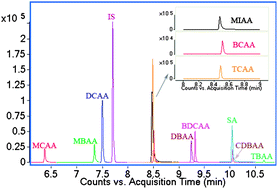Determination of ten haloacetic acids in water using gas chromatography-triple quadrupole mass spectrometry
Abstract
A sensitive

* Corresponding authors
a
Key Laboratory of Northwest Water Resources, Environment and Ecology, MOE, School of Municipal & Environmental Engineering Xi'an University of Architecture and Technology, 13 Yanta Road, Xi'an 710055, China
E-mail:
jinmingduan@xauat.edu.cn
Tel: +86 029 82201354
b Centre for Water Management and Reuse, University of South Australia, Mawson Lakes Campus, SA 5095, Australia
A sensitive

 Please wait while we load your content...
Something went wrong. Try again?
Please wait while we load your content...
Something went wrong. Try again?
W. Li, Y. Liu, J. Duan and D. Mulcahy, Anal. Methods, 2013, 5, 2258 DOI: 10.1039/C3AY26402E
To request permission to reproduce material from this article, please go to the Copyright Clearance Center request page.
If you are an author contributing to an RSC publication, you do not need to request permission provided correct acknowledgement is given.
If you are the author of this article, you do not need to request permission to reproduce figures and diagrams provided correct acknowledgement is given. If you want to reproduce the whole article in a third-party publication (excluding your thesis/dissertation for which permission is not required) please go to the Copyright Clearance Center request page.
Read more about how to correctly acknowledge RSC content.
 Fetching data from CrossRef.
Fetching data from CrossRef.
This may take some time to load.
Loading related content
